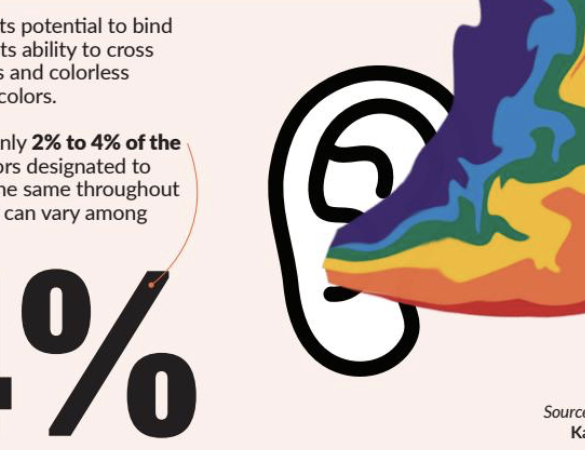Individuals who have Synesthesia or Color Vision Deficiency discuss how they experience their conditions.
Have you ever associated a school subject with a color? What about a number with a certain sound? This rare neurological condition is called Synesthesia. It only affects 3% to 5% of the entire population and can cause you to hear colors, taste sounds, feel the pain of others, and so much more.
Synesthesia is defined as the production of a sense impression relating to one sense or part of the body by stimulation of another part of the body.
Color Vision Deficiency (CVD) is defined as being unable to distinguish certain colors, or (rarely in humans) any color at all. There are three main types of CVD, Protanopia, Tritanopia, and Achromatopsia. You may know these more commonly as red-green, blue-yellow, and complete color blindness.
But to those who have never experienced these conditions, they may be hard to visualize.
Ball Bearings sat down with individuals who have color blindness or synesthesia to talk about how they experience their conditions.
Ball Bearings has edited statements for clarity.
Rachel Cooley is a synesthete from Terre Haute and an English teacher at Indiana State University and Ivy Tech.
I can remember it growing as a child, because I was learning things about language, time, shapes, and meeting new people. At the same time, the process of it developing came naturally. It always stuck.
I first learned about Synesthesia when I was going into my freshman year of college. I had heard about it and I was like “Oh, that sounds weird!” But then I thought about it and I realized “hey wait a minute that’s that thing that I do,” so it always kind of made me feel special because I didn’t know anything about it and a lot people I knew didn’t know much about it either, but I really like talking about it because it’s just one of those things that makes me unique.
As an English instructor, I am always curious to see what people are writing. I actually have a couple different types of Synesthesia. The main one is Grapheme Color, which is where language has a color. For me, all the letters of the alphabet have a color and every word in the language does have a color to me as well.
People with Synesthesia are typically very anal about colors, and trying to find the exact shade can be really frustrating when I am trying to show people what I see. Something that is less common, is I have Gustatory Synesthesia, so a lot of the words also have tastes. I didn’t think about this, but when I was younger, I can remember sitting in class, and I would get really hungry, because a teacher used a certain word.
I also have number personality. So numbers one through nine all have their characters. I can also taste faces. This isn’t as strong as when I was younger, I am not sure why. But, when Bill Clinton was president, [to me] he tastes like the sweet rolls from Texas Roadhouse. Marilyn Manson, the most dangerous man in America, tasted like the Jalapeño Poppers from Arby’s, and there are certain cartoon characters that will have a taste attached to them as well.
A lot of people have a musical Synesthesia. I don’t really know how to describe how I process music. Music has a texture more than a color to me. And also the months, to me, are vertical, and weeks are horizontal.
Abel Euler is an artist for her own company “Snazzy Starlight” out of Ann Arbor, Michigan, where she makes Synesthesia art.
I have Chromesthesia and Grapheme Color Synesthesia. I have the associative kind of synesthesia so when I hear music, it is like a daydream or a thought instead of it being projected out into the real world. But when I hear music, the best way to describe it is like those old Windows Media Players graphics. There is just a constant motion as the song plays.
I was 14 I believe, when I found out about Synesthesia. I was in psychology class and they brought it up. It sounded familiar to me, so I researched it and brought it up to my doctor and she agreed with me that it fit what I have.
Every song I hear is a little bit different. For example, Carrie Underwood and Blake Shelton sound and look massively different even though they’re in the same genre. Synesthesia is a lot more common than people think, and a lot of times people go their whole lives without knowing they have it, so they never report it. But I think it is an amazing thing that no two people see the same thing. I just think that’s really rad.
Claire Verboncoeur is a junior at Ball State University. She is an illustrator for the Daily News, and she is colorblind.
I can’t tell specific shades apart such as red and orange or blue and purple. Basically, I can’t tell apart colors that are touching on the color wheel.
I discovered I was colorblind during my freshman year of college. I was working on a color wheel for a class, and even though it looked correct to me, everyone else kept telling me it wasn’t correct. I tried Enchroma glasses one time, and I had never realized how bright neon colors actually were. It is amazing that you get to see the world in such bright beautiful colors because I see the world in a dimmer aspect. It is an opportunity to see the world brightly, so take advantage of it.




